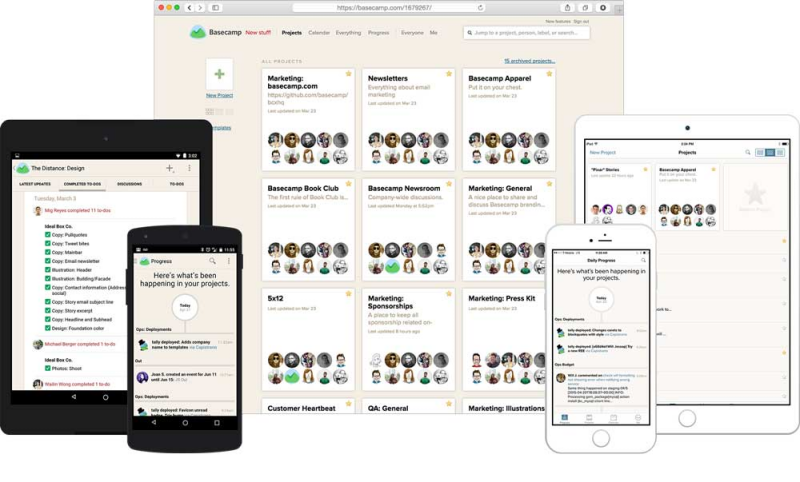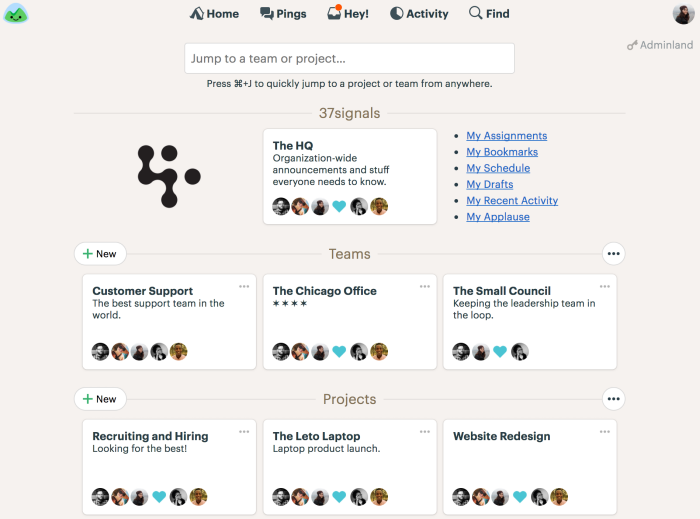 Basecamp online project management and team communication software is one of the pioneers in cloud productivity tools. The company 37signals started in 1999 as a web design company. To manage their projects, they developed Basecamp as an internal project management tool. In 2004, they shifted to web applications development and offered Basecamp to the public. Basecamp 2 was released in 2012, and the original Basecamp became Basecamp Classic. In 2014, Basecamp 3 was released. Also, the company renamed itself to Basecamp.
Basecamp online project management and team communication software is one of the pioneers in cloud productivity tools. The company 37signals started in 1999 as a web design company. To manage their projects, they developed Basecamp as an internal project management tool. In 2004, they shifted to web applications development and offered Basecamp to the public. Basecamp 2 was released in 2012, and the original Basecamp became Basecamp Classic. In 2014, Basecamp 3 was released. Also, the company renamed itself to Basecamp.
Basecamp 2
When Basecamp 2 was released, it offered a new interface, a discussion board, and several collaboration features. It enables people to be more organized and work better together towards a common goal. The PM tool keeps all project communication in one place and offers a better alternative than email for collaboration. Users are able to send status reports to their teammates. Also, they are able to manage multiple projects at the same time. Today, Basecamp 2 is still supported and secure. The company applies security patches to it regularly, although they no longer add new features to them. But it will continue to keep working in the same way for its existing customers.

It’s better to stay if…
Some Basecamp 2 features are not present in Basecamp 3. For example, the traditional grid view calendar is available only in Basecamp 2. Therefore, users who rely on the calendar feature should stay in Basecamp 2. Another difference is that there are more third-party applications that integrate in Basecamp 2 than in the newest version. Again, if users rely on a particular integration, and it is not available in the latest version, they should probably stay with Basecamp 2.
Another difference is the pricing scheme. Customers who are managing less than 40 projects at once will save on costs by staying in their current version. BC2 has a plan priced at $50 per month for users managing up to 40 projects, with 15GB file storage. BC3 is priced at a flat rate of $99 per month with unlimited projects and 500GB file storage.
Basecamp 3
When Basecamp 3 launched just 2 years after the second version, some customers also made the switch. Some of the reasons have to do with the features on their existing version. Some Basecamp 2 users found that communication is all over the place, so people were missing some tasks and deadlines. Project storage is decentralized, succession planning is difficult, and other features seem not optimized, resulting in people spending much time to go through the items and the communication. Basecamp 3 is a refinement, which put together the best ideas and features of the other versions.

Go switch now if…
Basecamp 3 captures and organizes all notifications in its Hey! menu. At-mentions, new messages, to-do assignments, and others all show up organized and threaded. Users can communicate depending on their needs. Pings are fast direct messages. Campfire is a group chat for casual conversations. Message Boards are great for centralized company-wide announcements. The new To-do Lists allow assignments to multiple people and setting a date range on top of a due date. Users can set Automatic Check-in reports on a regular basis. With the improved Client Access, users can share to-dos, messages, and others, only upon permission.
Users who need a Schedule tool with a focused line-by-line agenda view rather than a traditional calendar will find it in Basecamp 3. They can add any events from Schedule to their own Google, Outlook or iCalendar. The New Docs and Files has a more centralized and organized document management feature. They can create folders and subfolders. Linking Google Docs, Slides and Sheets are also possible. Other BC3 features include reply to emails, a more powerful search, setting notifications off temporarily, emoji boosts, new reports, and customizing the toolbox per project or team. Customers who need more storage will find the flat pricing of $99 per month with 500GB and unlimited projects more suitable.
Whatever you decide
Basecamp 3 is a redesigned product. It includes a variety of changes, tweaks, and adjustments that should be welcome additions. The latest version is more powerful, flexible, and straightforward than before. On the other hand, Basecamp 2 will remain safe and sound, and working always. Users can stay on it for as long as they like. However, if they decide to switch, they can bring their existing projects over to BC3 with a few exceptions. Another possibility is to use multiple versions at the same time. For a powerful integration that provides enhanced reporting and exporting capabilities, Bridge24 works with both Basecamp 2 and Basecamp 3.

To learn more about the latest release and announcements for Basecamp, visit also their Twitter or YouTube page.
Leave A Comment